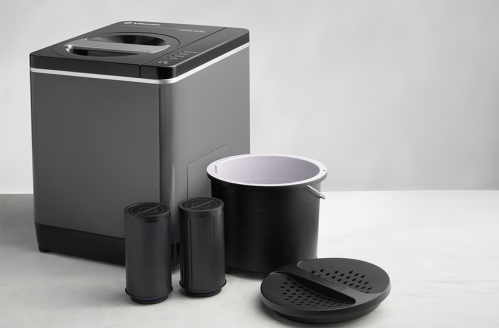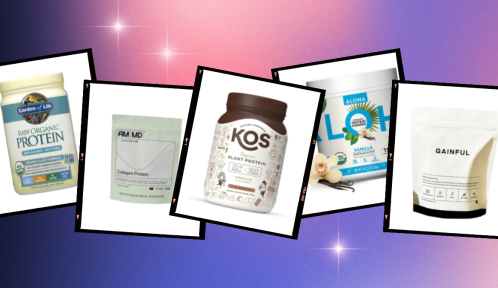Our editors independently select these products. Making a purchase through our links may earn Well+Good a commission
Composting is something I’ve always wanted to do. But, given that I live in an apartment without access to a yard and I refuse to live with a bin of worms in my living room, I always pictured it as something that future me would do once I own a home. And then the Vitamix FoodCycler FC-50 came into my life and changed everything. In a matter of hours, all of my food scraps are magically transformed into fertilizer. Food recycling technology has been available on an industrial scale for a while, explains Judson Cummins, senior manager of product management and innovation at Vitamix, but the FoodCycler brings it into your home.
Experts in This Article
Judson Cummins is the senior manager of product management and innovation at Vitamix, one of the most trusted brands in high performance blending technology.
“If you were cooking five, six, seven meals a week or more, you’re generating a lot of food waste,” says Cummins. “Since a relatively small amount of Americans are composting, that [waste] is just going right into the landfill. And there’s a better way to tackle that.”

The FoodCycler FC-50 arrived this summer as an update to Vitamix’s previous model. Instead of waiting weeks (or months) for your compost to mature, this machine creates fertilizer in three to eight hours. Because of the nature of the process, it doesn’t fit the legal definition of compost, but it still creates a nutrient-rich fertilizer that’s perfect for both indoor plants and outdoor gardens.
The machine dehydrates your food, grinds it up, and finally cools it. Your food scraps are now homemade fertilizer. The compact tool (it’s smaller than my microwave) is complete with a dishwasher-safe collection bucket and carbon filters to eliminate odors.
What it’s like to use the Vitamix FoodCycler FC-50
When I first got the FoodCycler, I imagined I’d run it once a week. But it quickly became a nightly habit or even twice a day. That’s because I live with three roommates and we all cook pretty regularly. It’s easy to use with a variety of scraps because, as Cummins says, your FoodCycler’s diet is as varied as your own.
“If I’m doing a perfect batch, I’ve got some broccoli stocks, I’ve got some onion peels, I’ve got some carrot tops, I’ve got maybe two or three days worth of coffee grinds in there,” he says. You don’t want too much of one type of food. “I wouldn’t throw like 40 banana peels in there, but if I had some leafy greens, some leftover chicken breasts, some black beans—I wouldn’t be worried about throwing five or six, seven banana peels in there.” You don’t want to throw in a ton of sugary fruits in by themselves because the high heat might cause them to caramelize.
Say you made a ton of apple pies and now have a bucket’s worth of peels and cores. Instead of running them together, you’d want to save them to add into more diverse mixtures. A good way to preserve scraps is the freezer, says Cummins. You can also use the FoodCycler to get rid of moldy leftovers or fruit, but if you notice an excess of mold growing inside of the FoodCycler, run it and then toss it—while the high heat kills any spores it’s best not to feed fertilizer with high concentration of mold in it to your plants.
As much as I love the Vitamix FoodCycler, the biggest downside is that it’s not cheap. If you’re looking to invest in a worm-free composter, it’s one of the best options out there. Bamboozle also makes a (much more affordable) worm-free countertop composter ($40). But, once it’s full, you move it outside to mature and then it takes two to five weeks for your scraps to become compost.
What to do with your fertilizer
Once you’ve run your cycle, store it in an airtight container until you’re ready to use it. Cummins uses the FoodCycler to create the fertilizer for his garden.
“When I was generating food waste last winter, I was keeping my fertilizer for this springs planting season,” he says. “When I was planning a new bed, I mixed the fertilizer about 11-to-1 ratio, soil to food fertilizer, and I just mixed that into the soil and I gave it about two weeks before I planted anything, I’m having a great growing season.”
But, if you’re like me and don’t have a garden, you’ll likely produce way more fertilizer than you can use in house plants. Consider reaching out to a local community garden or farm and see if you can donate it to them. And it could be a cute gift. Weird, but cute.
Examining your waste
Though I love my FoodCycler, it’s made me realize how much food waste my roommates and I produce. It’s jarring to see how often we run it. And that’s kind of the point. You should get use out of the machine, but over time Cummins hopes it’ll help you to become more conscious of your waste production.
“If you use it less, then that means you’re optimizing your supply of food to your demand of food. And if you find yourself using the FoodCycler a lot when you first buy it, you’re probably wasting too much food,” says Cummins. “Maybe it helps people save money at the store by buying less, or maybe it makes people try to be more adventurous when they cook and try to use some of their food waste.”
Oh hi! You look like someone who loves free workouts, discounts for cult-fave wellness brands, and exclusive Well+Good content. Sign up for Well+, our online community of wellness insiders, and unlock your rewards instantly.
Sign up for the Well+Good SHOP Newsletter
Get exclusive deals on wellness, beauty, fitness, and food products that have been hand-picked by our editors.
Got it, you've been added to our email list.











